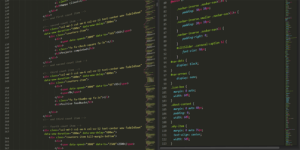Table of Contents
Have you ever wondered what the differences are between node.js, react, and webpack? Are these technologies just buzzwords that have no actual value or do they offer real benefits that warrant consideration? What implementation models are best for each given their differences? These are all important questions to consider when it comes to the ever-evolving landscape of web technologies.
In today’s world it’s more important than ever to have an understanding of the latest technologies and frameworks when it comes to web development. While some of these technologies have been around for years, others such as node.js, react, and webpack are relatively new and thus, understanding the differences between them can be confusing. Node.js is a JavaScript runtime that allows developers to write code on the server-side. React is a JavaScript library for building user interfaces and webpack is an open source module bundler.
In this article, You will learn how each of these technologies operate and affect web development, what the implementations models are for each, and the advantages and disadvantages of each technology. There will be examples of practical applications of each of these technologies as well as considerations for choosing the right one for any given project. Furthermore, solutions to common problems and best practices when utilizing any of these technologies will be discussed so that readers can make the best decisions when deciding which technology to use for their own web projects.End with new line.
Definitions:
Node.js is a JavaScript runtime environment used to create web applications. It is open-source and uses the V8 JavaScript engine, which allows users to create dynamic web apps with JavaScript. Node.js also allows users to control their backend, databases, and other aspects of their web app.
React is a JavaScript library used to create web applications. React was created by Facebook, and it provides a component-based approach to web development. It is used to create interactive user interfaces, and it is often used in combination with frameworks such as Angular and Vue.
Webpack is an open-source tool used for bundling JavaScript files. It allows users to load multiple JavaScript files for their web apps, which is essential for larger web applications. It also helps to reduce the loading time of web apps by reducing the size of the files that are sent across the network.
Heading 1: What is Node.js?
What is Node.js?
Node.js is an open-source, cross-platform JavaScript runtime environment used for developing server-side and networking applications. Node.js is built on Google Chrome’s JavaScript runtime and allows the developer to write server-side applications using JavaScript. Node.js enables developers to write JavaScript on the server side of a web application, creating a more effective web development experience.
Features of Node.js
Node.js has many features that make it attractive to developers. These include:
- Non-blocking I/O operations
- A large library of modules and packages
- Excellent performance
- Scalability and speed of development
- Support for various databases
- The ability to handle multiple concurrent requests/responses
Benefits of Node.js
There are several benefits to using Node.js for developing server-side applications, such as:
- Efficient and fast development process
- It can handle requests asynchronously
- It is lightweight and efficient
- It can be used to build real-time applications
- It’s easy to scale
- It has many open-source libraries and tools
The other two libraries, React and Webpack, are also open source libraries used for web development. React is a JavaScript library for building user interfaces, while Webpack is a module bundler used to package JavaScript files for an application. Both are used to create rich, interactive web applications.
Heading 2: What is React?
React is a JavaScript library used for building user interface components. It is the most popular front-end library for modern web development and is used by millions of developers worldwide. React was created by Facebook in 2011 and has since become one of the most popular frameworks for creating rolling out complex user interfaces.
React uses an HTML-like code called JSX (which stands for JavaScript Extension) to create components and UI elements. This code contains JavaScript and HTML, and is used to create components that are easily reusable. React also provides a set of tools to manage the states of these components, making it easy to create user interfaces that are both powerful and easy-to-maintain.
The core of React development is React Components. Components are basic building blocks of React. In React, components are the only things that contain their own state and render HTML elements. With components, developers can define how different parts of a UI should look and behave. Components can also be composed of other components, creating functional building blocks that render the UI.
The power of React lies in its layers of abstraction. By abstracting code into components, developers can focus on logic instead of implementation, making it easier to work with and maintain complex code base. In addition, these components make it easier to debug and troubleshoot any issues that may arise when developing an application. With all these advantages, React is a powerful tool for creating modern user interfaces.
Heading 3: What is Webpack?
Webpack is an open-source tool used to bundle JavaScript modules, images, fonts, and other assets for applications used across multiple platforms including web and mobile. It assembles all the necessary pieces in a single file bundle that can be easily used by the browser. Webpack also helps to securely minify code that can improve the performance of an application or website.
What are the features of Webpack?
Webpack provides developers with plenty of features, allowing them to easily manage and optimize their applications. Some of the most notable features of Webpack include:
Code Splitting: Webpack allows developers to split their application code into multiple bundles for faster loading times. This feature also helps to reduce the bandwidth costs for loading assets in the application.
Hot Module Replacement (HMR): This feature enables developers to make small changes to their code without having to restart the entire application. This helps to speed up the development process as all the changes will be reflected in real-time.
Tree Shaking: This feature helps to reduce the size of large applications by shaking off unused pieces of code from the compiled within bundles. This will reduce the time needed for page loading and improve the overall performance of the application or website.
What are the Benefits of Webpack?
Webpack is a powerful tool that helps developers create applications with ease. The benefits of Webpack can be summarized as follows:
Optimized Performance: Webpack helps to deliver a better user experience by enabling faster page loading times and reducing the bandwidth usage while loading assets in an application.
Efficient Building Process: Webpack makes application building simple by eliminating manual tasks and reducing the time needed for completing the development cycle.
Cross-Platform Compatibility: Webpack is compatible with multiple platforms including the web, desktop and mobile. This makes it easier to create applications that can be accessed across different devices.
Secure Minification Feature: Webpack helps to securely minify code that can further improve the speed of an application.
Conclusion
and answers in HTML Tag. Also, use #1, #2, #3, #4, #5 for numbering FAQ questions.
Have you ever wondered how node.js, React, and webpack interact with each other? It’s a fascinating topic with lots of potential, and our blog is the perfect place to explore it. Keep checking back for insightful pieces and exciting new releases!
If you’re looking for a comprehensive understanding of the nuances of node.js, React, and webpack, our blog will provide you with plenty of articles and resources. Be sure to follow us to stay up to date on the latest releases!
FAQ:
#1 What is Node.js?
Node.js is an asynchronous event-driven JavaScript runtime that is designed to build scalable network applications. It is an open-source, cross-platform JavaScript runtime environment that executes code outside of a browser.
#2 What is React?
React is a JavaScript library for building user interfaces. It is used to create composable user interfaces for front-end development. It is maintained by Facebook and a composer of individual developers and corporations.
#3 What is webpack?
Webpack is a tool for bundling the application’s assets. It enables developers to pack many modules into a few bundles for the browser to load. It also provides a powerful plugin system, wired into a common API to further tune and optimize the asset bundling process.
#4 How do these technologies interact?
Node.js, React, and webpack interact with each other by allowing developers to build scalable web applications with less code. Node.js serves as the backend runtime environment where React provides the user interface, while webpack allows developers to bundle web application assets into fewer final bundles, reducing load time.
#5 What are the benefits of combining the three?
The combination of Node.js, React, and webpack allows developers to quickly develop efficient, reliable web applications. It also enables them to improve the performance of their applications by reducing threading and load times, without compromising on quality.

